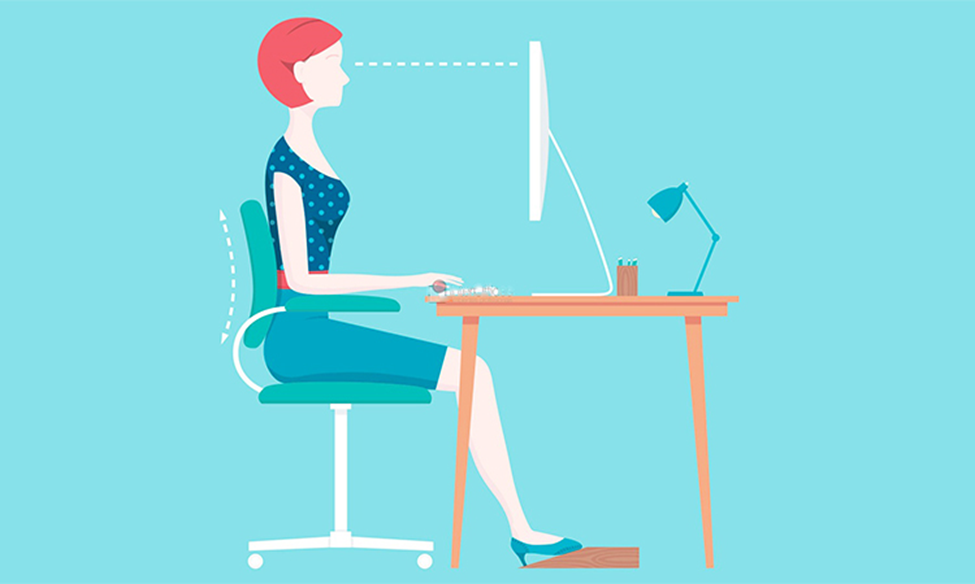
Ergonomics. It is a fun word to say. But how often do you think about ergonomic principles affecting your everyday life? Is your relationship with ergonomics more of the common knowledge variety, where vague images of deluxe office chairs and oddly shaped keyboards come to mind? Or have you been an avid ergonomist for years, with functional design principles dictating your entire desktop setup? Try testing your ergonomic expertise with this easy quiz!
1. Ergonomics is an applied science concerned with efficiency and safety.
a. True
b. False
2. The top of your computer monitor should be:
a. Slightly lower than eye level
b. At eye level
c. Slightly higher than eye level
3. Your office chair should have a straight back to support proper posture.
a. True
b. False
4. When typing your wrists should be:
a. Lower than the back of your hands
b. Higher than the back of your hands
c. Straight with the back of your hands
5. Having your desktop or chair armrest height slightly higher than your elbow height:
a. Can put a strain on your back, shoulder and neck muscles
b. Provides proper alignment and is ergonomically correct
c. Works well as long as you have a comfortable chair
6. The distance between you and your computer monitor should be:
a. About an arm’s length
b. 18-24 inches
c. Both A and B
7. The angles at your elbows, hips, and knees while sitting at your desk should be between 90-120 degrees.
a. True
b. False
8. Practicing proactive ergonomics can lower your chance of experiencing musculoskeletal disorders (MSDs) caused by specific work tasks.
a. True
b. False
9. When working on the computer, it is best for your eyes to have:
a. Side lighting
b. Overhead lighting
c. No other lighting
10. If you invest in a high-quality ergonomic chair or a standing desk, it is okay to stay at your desk all day.
a. True
b. False
Answers:
1. A—True. Merriam-Webster’s Dictionary defines ergonomics as “an applied science concerned with designing and arranging things people use so that the people and things interact most efficiently and safely.”
2. B—Although A can work as well, especially if you wear bifocals.
3. B—False. Your desk chair should conform to the natural curve of your spine and provide sufficient lumbar support.
4. C—When typing, your forearms, wrists and the back of your hands should be in a straight line. An ergonomic wrist rest placed in front of your keyboard can help provide this alignment.
5. A—Experts recommend having your desktop and chair armrests no higher than your natural elbow height. Having a higher desktop or armrests can raise your shoulders slightly leading to tension in your back, shoulder and neck muscles.
6. C—Typically the monitor should be 18-24 inches or an arm’s length away from you. The wider the width of your monitor, the further back you should be from your screen.
7. A—True. Being aware of proper body alignment and sitting with your elbows, hips, and knees all at the beneficial angles can lessen workday muscle fatigue.
8. A.—True. While congenital structural issues, past injuries, and overall health can impact your chance of having a musculoskeletal disorder (MSD), you can lessen the risk of experiencing a work-related MSD through proactive workplace ergonomics.
9. B—Bright overhead lighting can create glare or be too strong and strain the eyes when working on the computer. Having little to no ambient light while staring at a screen can also hurt your eyes. Ideally, turn on a diffused light source to the side of your monitor to create the least amount of eyestrain.
10. B—False. Regardless of how ergonomic your desk setup, it is still essential to provide a mix of movement throughout your work. Experts recommend taking a break from deskwork every 20-30 minutes. It is vital to regularly stretch your body, relax your muscles, and provide a rest for your eyes throughout the workday.
Are you feeling the urge to make some functional design upgrades to your workspace? Check out what is available at UNL Inventory on Wednesdays from 8:30 am to 1:00 pm: https://inventory.unl.edu.
Looking for more tips on how to incorporate excellent ergonomics into your workday and ease your musculoskeletal pain while improving productivity? Peruse these helpful links:
“Workstation Ergonomics,” an informative video clip by Martela: Inspiring Spaces: https://youtu.be/MTL8EBBH69o
“Correct Sitting Posture: Working at a Desk,” by Physio Med Limited. This guide provides EXCELLENT illustrations: https://www.physiomed.co.uk/uploads/guide/file/22/Physiomed_Sitting_Guide_-_Working_at_a_Desk_Digital.pdf
“Safe Operating Procedure: Ergonomic Considerations for Offices,” by UNL: https://ehs.unl.edu/sop/s-ergo_office.pdf
“Infographic: Office Stretches to Prevent and Reduce Desk-Life Pain,” ErgoPlus: https://ergo-plus.com/infographic-office-stretches-prevent-reduce-desk-life-pain
“Get Moving!” a short video clip with office stretches and exercises by UNL: https://go.unl.edu/3g37
“Ergonomics,” Occupational Safety and Health Administration (OSHA): https://www.osha.gov/SLTC/ergonomics
Additional Workplace Wellness Resources for the Month:
April’s 2019 Top Health Newsletter: https://nebraska.edu/docs/benefits/newsletters/April2019TopHealth.pdf
UNL’s Wellness Website: https://wellness.unl.edu
Citations:
1. Merriam-Webster Dictionary. “Ergonomics.” 2019. https://www.merriam-webster.com/dictionary/ergonomics.
2. “Correct Sitting Posture: Working at a Desk.” Physio Med Limited: In touch with the way you work. https://www.physiomed.co.uk/uploads/guide/file/22/Physiomed_Sitting_Guide_-_Working_at_a_Desk_Digital.pdf.
3. “Office ergonomics: Your how-to guide.” Mayo Clinic: Healthy Lifestyle Adult Health. 20 April 2016. https://www.mayoclinic.org/healthy-lifestyle/adult-health/in-depth/office-ergonomics/art-20046169.
Disclaimer: These statements are not intended to diagnose, treat or cure any condition. Always check with your doctor before making lifestyle changes, especially if you have a medical condition.